China–United States relations
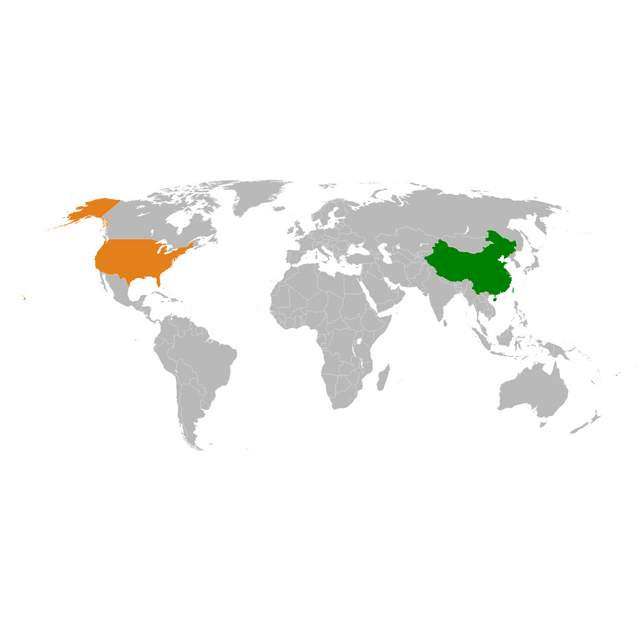
China–United States relations

China | United States |
|---|---|
| Diplomatic mission | |
| Chinese Embassy, Washington, D.C. | United States Embassy, Beijing |
| Envoy | |
| Ambassador Cui Tiankai | Ambassador Terry Branstad |
China–United States relations (simplified Chinese: 中美关系; traditional Chinese: 中美關係; pinyin: Zhōngměi Guānxì), also known as U.S.–Chinese relations, Chinese–U.S. relations, or Sino-American relations, refers to international relations between China and the United States. The history of the relationship can be traced back to when the United States first gained independence. The relationship between the two countries have been, until the last years, quite strong, complex and even somewhat positive in various aspects. Both countries used to have an extremely extensive economic partnership, and the great amount of trade between the two countries necessitated for constructive political relations, yet significant issues do exist. It is a relationship of economic cooperation, hegemonic rivalry in the Pacific, and mutual suspicion over the other's intentions. Therefore, each nation has adopted a wary attitude regarding the other as a potential adversary; whilst maintaining an extremely strong economic partnership at the same time.[1] It has been described by world leaders and academics as the world's most important bilateral relationship of the 21st century.[2][3]
As of 2019, the United States has the world's largest economy and China has the second largest, although China has a larger GDP when measured by PPP.[4] Historically, relations between the two countries have generally been stable with some periods of open conflict, most notably during the Korean War and the Vietnam War. Currently, China and the United States have mutual political, economic, and security interests, including but not limited to the proliferation of nuclear weapons, although there are unresolved concerns relating to the role of democracy in government in China and human rights in both respective countries. China is the second largest foreign creditor of the United States after Japan.[5] The two countries remain in dispute over territorial issues in the South China Sea.[6]
According to a 2017 BBC World Service poll, 33% of the Chinese view America's influence positively, with 61% expressing a negative view. Likewise, only 22% of Americans view China's influence positively and 70% negatively.[7] According to a 2019 survey by the Pew Research Center, 26% of Americans have a favorable view of China, with 60% expressing an unfavorable view.[8] The poll also found that 24% of Americans see China as the number one threat to the US.[8] Relations with China began under George Washington,[9] leading to the 1845 Treaty of Wangxia. The U.S. was allied to the Republic of China during the Pacific War, but, after the Communist victory in the mainland in the Chinese Civil War, fought a major armed conflict with the People's Republic of China in the Korean War, and did not establish relations with the People's Republic of China for 25 years, until Richard Nixon's 1972 visit to China. Since Nixon's visit, every successive U.S. president, with the exception of Jimmy Carter, has toured China. Relations with China have strained under Barack Obama's Asia pivot strategy, U.S. support for Japan in the Senkaku Islands dispute. Despite tensions during his term, the Chinese population's favorability of the U.S. stood at 51% in Obama's last year of 2016, only to dip during the Trump Administration.[10]
The relations deteriorated sharply under President Donald Trump, whose administration launched a trade war against China, banned US companies from selling equipment to Huawei, increased visa restrictions on Chinese nationality students and scholars and designated China as a "currency manipulator".[11][12][13][14][15] During the Trump administration, and especially since the US-China trade war began, political observers have started to warn that a new cold war is emerging.[16][17][18][19] Michael D. Swaine warned in 2019 that, "The often positive and optimistic forces, interests, and beliefs that sustained bilateral ties for decades are giving way to undue pessimism, hostility, and a zero-sum mindset in almost every area of engagement."[20]
China | United States |
|---|---|
| Diplomatic mission | |
| Chinese Embassy, Washington, D.C. | United States Embassy, Beijing |
| Envoy | |
| Ambassador Cui Tiankai | Ambassador Terry Branstad |
Country comparison
Leaders of China and the United States from 1950
The Qing Dynasty and the United States
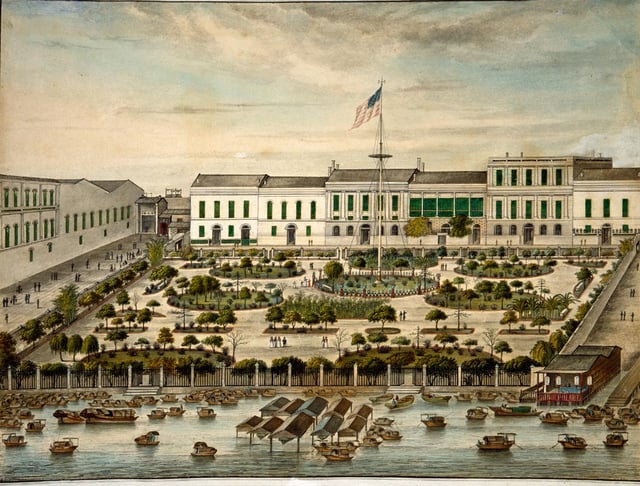
The American Garden at the Thirteen Factories in Canton, 1844–45
In 1784 the United States attempted to send a consul to China, but he was not received by the Chinese government. Formal diplomatic relations between the United States and the Chinese Empire began June 16, 1844 as the countries engaged in the negotiations which led to the Treaty of Wangxia.[9]
Old China Trade
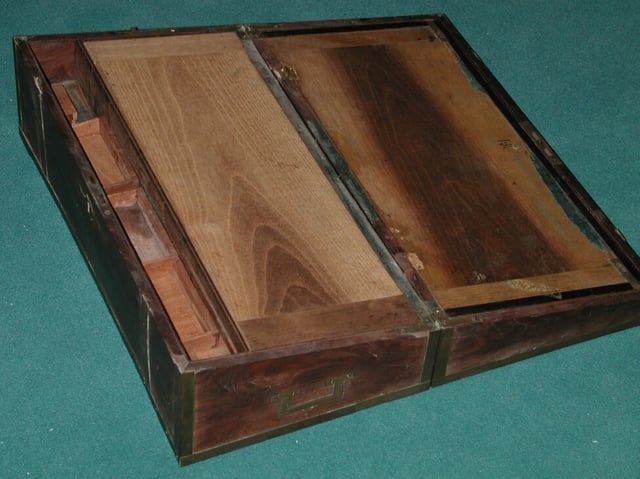
An example of a Chinese-made lap desk from the early 1800s. Lap desks such as these were especially popular among American merchants, who used them to write letters or conduct business during their lengthy voyages at sea.
The American merchants, mostly based in the East India Marine Society in Salem, Massachusetts, became extremely wealthy, eventually giving rise to America's first generation of millionaires.[26] In addition, many Chinese artisans began to notice the American desire for exotic wares and adjusted their practices accordingly, manufacturing goods made specifically for export. These export wares often sported American or European motifs in order to fully capitalize on the consumer demographic.[27][28]
Caleb Cushing mission
After the 1842 Treaty of Nanking at the end of the First Opium War in 1842, many Chinese ports were forced to open to foreign trade, which threatened American trade in the region. President John Tyler In 1843 appointed Massachusetts diplomat Caleb Cushing as commissioner and Minister. With the goal of impressing the Royal Chinese court, the Cushing mission suddenly appeared with four American warships, loaded with gifts that exalted scientific wonders including revolvers, telescopes, and an encyclopedia. His arrival at Macau in February 1844 created a local sensation, but the Chinese government was reluctant to designate another most favored nation. Cushing cleverly mixed the carrot and stick. He warned – against the backdrop of his warships – that not to receive an envoy was a national insult. He threatened to go directly to the Emperor – an unheard of procedure. The Emperor tried delay, but he finally sent an envoy to negotiate with Cushing, leading to the signing of the Treaty of Wanghia in the village of Wanghia on July 3, 1844. In addition to most favored nation status, Cushing made sure that Americans received extraterritoriality, which meant that legal cases involving Americans inside China would be tried by Western judges, not by Chinese judges. In the following years American trade with China grew rapidly, thanks to the high-speed clipper ships which carried relatively small amounts of high-value cargo, such as ginseng and silk. American Protestant missionaries also began to arrive. The popular Chinese reaction was mostly hostile, but there was a favorable element that provided a base of support for American missionaries and businessmen. By 1850-64, China was emeshed in the Taiping rebellion which caused millions of lives, and foreign trade stagnated.[29][30][31][32]
During the Second Opium War, American and Qing forces briefly clashed at the Battle of the Barrier Forts, the first instance of military engagement between the United States and China. After China's defeat in the Second Opium War, the then emperor of China, Xianfeng, fled Beijing. His brother Yixin, the Prince Gong, ratified the Treaty of Tientsin in the Convention of Peking on October 18, 1860. This treaty stipulated, among other terms, that along with Great Britain, France, and Russia, the United States would have the right to station legation offices in Beijing.[33]
Taiwan
Some Americans advocated for the annexation of Taiwan from China.[34][35][36] Aboriginals from Taiwan often attacked and massacred shipwrecked Western sailors.[37][38][39][40] In 1867, during the Rover incident, Taiwanese aborigines attacked shipwrecked American sailors, killing the entire crew.[41] They subsequently skirmished against and defeated a retaliatory expedition by the American military and killed another American during the battle.[42][43] (For the current issues facing Taiwan, see below)
The Burlingame Treaty and the Chinese Exclusion Act
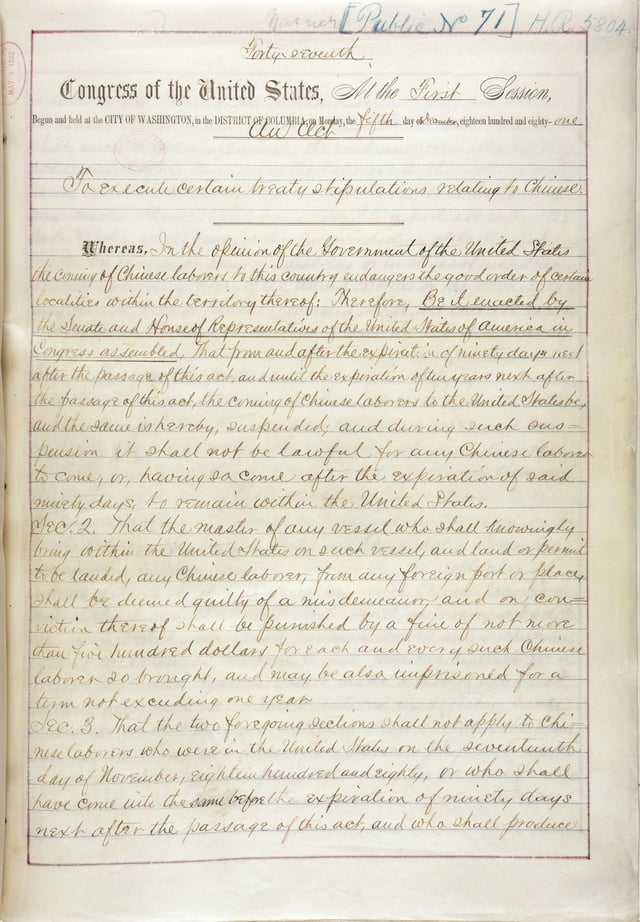
The first page of the Chinese Exclusion Act of 1882
In 1868, the Qing government appointed Anson Burlingame as their emissary to the United States. Burlingame toured the country to build support for equitable treatment for China and for Chinese emigrants. The 1868 Burlingame Treaty embodied these principles. In 1871, the Chinese Educational Mission brought the first of two groups of 120 Chinese boys to study in the United States. They were led by Yung Wing, the first Chinese man to graduate from an American university.
During the California Gold Rush and the construction of the transcontinental railroad, large numbers of Chinese emigrated to the U.S., spurring animosity from American citizens. After being forcibly driven from the mines, most Chinese settled in Chinatowns in cities such as San Francisco, taking up low-end wage labor, such as restaurant and cleaning work. With the post-Civil War economy in decline by the 1870s, anti-Chinese animosity became politicized by labor leader Denis Kearney and his party, as well as by the California governor John Bigler. Both blamed Chinese coolies for depressed wage levels.
In the first significant restriction on free immigration in U.S. history, Congress passed the Chinese Exclusion Act on May 6, 1882, following revisions made in 1880 to the Burlingame Treaty. Those revisions allowed the United States to suspend immigration, and Congress acted quickly to implement the suspension of Chinese immigration and exclude Chinese skilled and unskilled laborers from entering the country for ten years, under penalty of imprisonment and deportation. The ban was renewed a number of times, lasting for over 60 years.
Searching for the China market
The American China Development Company, founded in 1895 by industrialists J.P. Morgan and Andrew Carnegie, sought to provide the American capital and management that would generate a rapid industrialization of China. It started building the Hankow-Canton Railroad, to link central and southern China. It only managed to finish 30 miles of line. Americans soon grew disillusioned, and sold out to a rival Belgian syndicate.[44] On the whole, the American dream of getting rich by investing in China or selling to hundreds of millions of Chinese was almost always a failure. Standard Oil did succeed in selling kerosene to the China market, but few others made a profit.[45]
The Boxer Rebellion
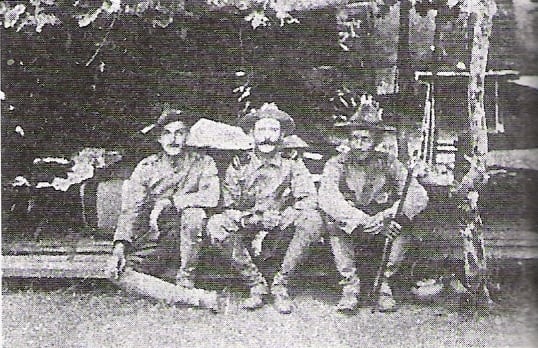
US troops in China during the Boxer Rebellion in 1900

U.S. Marines fight rebellious Boxers outside Beijing Legation Quarter, 1900. Copy of painting by Sergeant John Clymer.
In 1899, a movement of Chinese nationalists calling themselves the Society of Right and Harmonious Fists started a violent revolt in China, referred to by Westerners as the Boxer Rebellion, against foreign influence in trade, politics, religion, and technology. The campaigns took place from November 1899 to September 7, 1901, during the final years of Manchu rule in China under the Qing dynasty.[46]
The uprising began as an anti-foreign, anti-imperialist, peasant-based movement in northern China, in response to foreign westerners seizing land from locals, concession grabbing, and granting immunity to criminals who converted to Catholicism. The insurgents attacked foreigners, who were building railroads and violating Feng shui, and Christians, who were held responsible for the foreign domination of China. In June 1900, the Boxers entered Peking, and ransacked the area around the Foreign Legations. On June 21, in response to the Western attack on the Chinese Dagu Forts, Empress Dowager Cixi declared war against all Western powers. Diplomats, foreign civilians, soldiers, and Chinese Christians were besieged during the Siege of the International Legations for 55 days. A coalition called the Eight-Nation Alliance comprising Austria-Hungary, France, Germany, Italy, Japan, Russia, Britain and the United States rushed 20,000 troops to their rescue. The multinational forces were initially defeated by a Chinese Muslim army at the Battle of Langfang, but the second attempt in the Gaselee Expedition was successful due to internal rivalries among the Chinese forces.
The Chinese government was forced to indemnify the victims and make many additional concessions. Subsequent reforms implemented after the rebellion contributed to the end of the Qing dynasty and the establishment of the modern Chinese Republic. The United States played a secondary but significant role in suppressing the Boxer Rebellion, largely due to the presence of US ships and troops deployed in the Philippines since the American conquest of the Spanish–American and Philippine–American War. Within the United States Armed Forces, the suppression of the Boxer Rebellion was known as the China Relief Expedition.
With national attention focused on the Boxers, American Protestants made missions to China a high priority. They supported 500 missionaries in 1890, more than 2000 in 1914, and 8300 in 1920. By 1927 they opened 16 American universities, six medical schools, and four theology schools, together with 265 middle schools and a large number of elementary schools.The number of converts was not large, but the educational influence was dramatic.[49]
Open Door Policy
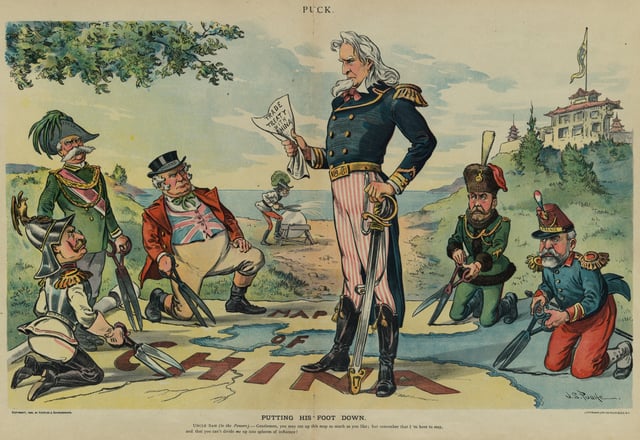
"Putting his foot down" Uncle Sam in 1899 demands Open Door while major powers plan to cut up China for themselves; Germany, Italy, England, Austria, Russia & France are represented by Wilhelm II, Umberto I, John Bull, Franz Joseph I (in rear) Uncle Sam, Nicholas II, and Emile Loubet. Punch Aug 23, 1899 by J. S. Pughe

Residence of China's envoy Wu Tingfang
In the 1890s the major world powers (France, Britain, Germany, Japan, and Russia) began carving out spheres of influence for themselves in China, which was then under the Qing dynasty. The United States demanded this practice to end so that all nations could trade on an equal footing. In 1899, U.S. Secretary of State John Hay sent diplomatic letters to these nations, asking them to guarantee the territorial and administrative integrity of China and to not interfere with the free use of treaty ports within their respective spheres of influence.[50] The major powers evaded commitment, saying they could not agree to anything until the other powers had consented first. Hay took this as acceptance of his proposal, which came to be known as the Open Door Policy.[51]
While respected internationally, the Open Door Policy was ignored by Russia and Japan when they encroached in Manchuria. The U.S. protested Russia's actions. Japan and Russia fought the Russo-Japanese War in 1904, in which the U.S. mediated a peace. Japan also presented a further challenge to the policy with its Twenty-One Demands in 1915 made on the then-Republic of China. Japan also made secret treaties with the Allied Powers promising Japan the German territories in China. In 1931, Japan invaded and occupied Manchuria. The United States along with other countries condemned the action, leading to U.S. support for China in its war with Japan after 1937.[52]
The Republic of China and the United States
1911–1937
After the Xinhai Revolution in 1911, the United States government recognized the Government of the Chinese Republic as the sole and legitimate government of China despite a number of governments ruling various parts of China. China was reunified by a single government, led by the Kuomintang (KMT) in 1928. The first winner of the Nobel Prize in Literature for writing about China was an American, born in the United States but raised in China, Pearl S. Buck, whose 1938 Nobel lecture was titled The Chinese Novel.[53]
Starting in the 1870s, American missionaries began developing educational institutions in China. They discovered the demand for Western education was much stronger, and much more elite, than the demand for Christianity. Programs were set up to fund Chinese students In American colleges.[54]
World War II
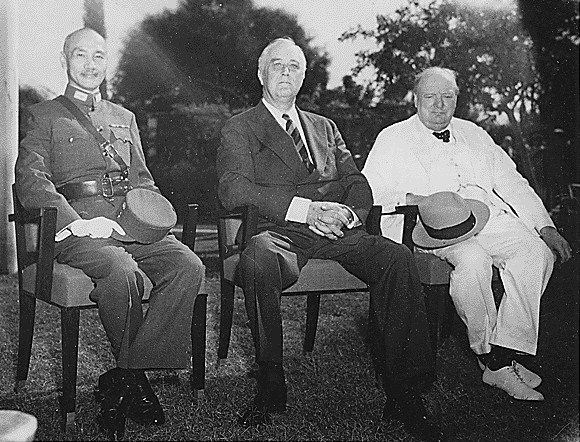
Chiang Kai-shek, Franklin D. Roosevelt, and Winston Churchill at the Cairo Conference in 1943.
The outbreak of the Second Sino-Japanese War in 1937 saw aid flow into the Republic of China (ROC), from the United States under President Franklin D. Roosevelt. A series of Neutrality Acts had been passed in the US with the support of isolationists who forbade American aid to countries at war. Because the Second Sino-Japanese War was undeclared, however, Roosevelt denied that a state of war existed in China and proceeded to send aid to Chiang.
American public sympathy for the Chinese was aroused by reports from missionaries, novelists such as Pearl S. Buck, and Time Magazine of Japanese brutality in China, including reports surrounding the Nanking Massacre, also known as the 'Rape of Nanking'. Japanese-American relations were further soured by the USS Panay incident during the bombing of Nanjing, in which a gunboat of the US Navy was accidentally sunk by Japanese aircraft. Roosevelt demanded an apology and compensation from the Japanese, which was received, but relations between the two countries continued to deteriorate.[55] American public opinion overwhelmingly favored China and denounced Japan.[56]
The United States formally declared war on Japan in December 1941 following the Japanese surprise attack on Pearl Harbor. The Roosevelt administration gave massive amounts of aid to Chiang's beleaguered government, now headquartered in Chungking. Madame Chiang Kai-shek,[57] who had been educated in the United States, addressed the US Congress and toured the country to rally support for China. Congress amended the Chinese Exclusion Act and Roosevelt moved to end the unequal treaties by establishing the Treaty for Relinquishment of Extraterritorial Rights in China. However, the perception that Chiang's government was unable to effectively resist the Japanese or that he preferred to focus more on defeating the Communists grew. China Hands such as Joseph "Vinegar Joe" Stilwell—who spoke fluent Mandarin Chinese—argued that it was in American interest to establish communication with the Communists to prepare for a land-based counteroffensive invasion of Japan. The Dixie Mission, which began in 1943, was the first official American contact with the Communists. Other Americans, such as Claire Lee Chennault, argued for air power and supported Chiang's position. In 1944, successfully demanded that Stilwell be recalled. General Albert Coady Wedemeyer replaced Stilwell, and Patrick J. Hurley became ambassador.[58][59]
Civil War in Mainland China
After World War II ended in 1945, the hostility between the Nationalists and the Communists exploded into the open Chinese Civil War. President Truman dispatched General George Marshall to China to mediate, but the Marshall Mission was not successful.[60] In February 1948, Marshall, now Secretary of State, testified to Congress in secret session that he had realized from the start that the Nationalists could never defeat the Communists in the field, so some sort of negotiated settlement was necessary or else the United States would have to fight the war. He warned:
- any large-scale United States effort to assist the Chinese Government to oppose the Communists would most probably degenerate into a direct U.S. undertaking and responsibility, involving the commitment of sizable forces and resources over an indefinite period. Such a dissipation of U.S. resources would inevitably play into the hands of the Russians, or would provoke a reaction which would possibly, even probably, lead to another Spanish type of revolution or general hostilities....the cost of an all-out effort to see Communist forces resisted and destroyed in China...would clearly be out of all proportion to the results to be obtained.[61]
When it became clear that the KMT would lose effective control of mainland China in 1949, Secretary of State Dean Acheson directed the publication of the China White Paper to explain American policy and defend against critics who asked "Who Lost China?" He announced that that the United States would "wait for the dust to settle" before recognizing the new government. Chinese Military forces under Chiang Kai-shek had gone to the island of Taiwan to accept the surrender of Japanese troops, thus beginning the military occupation of Taiwan, and withdrew to the island in 1948 and 1949.[60] Chinese Communist Party Chairman Mao Zedong established the People's Republic of China in mainland China, while Taiwan and other islands are still under the control of the Republic of China.[62][63][64][65]
Cold War relations

Eisenhower, Soong Mei-ling, and ROC president Chiang Kai-shek in Taiwan. 1960.
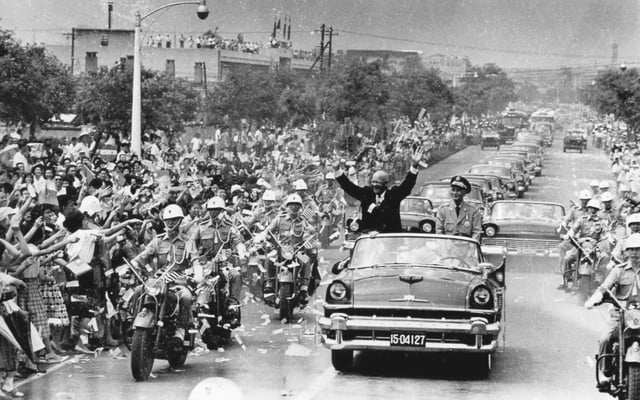
With President Chiang Kai-shek, the U.S. President Dwight D. Eisenhower waved hands to crowds during his visit to Taipei, Taiwan in June 1960.
After the Korean War broke out, the Truman administration resumed economic and military aid to the ROC and neutralized Taiwan Strait by United States Seventh Fleet to stop a Communist invasion of Formosa. Until the US formally recognized China in 1979, Washington provided ROC with financial grants based on the Foreign Assistance Act,[66] Mutual Security Act and Act for International Development enacted by the US Congress. A separate Sino-American Mutual Defense Treaty was signed between the two governments of US and ROC in 1954 and lasted until 1979.
The U.S. State Department's official position in 1959 was:
- That the provisional capital of the Republic of China has been at Taipei, Taiwan (Formosa) since December 1949; that the Government of the Republic of China exercises authority over the island; that the sovereignty of Formosa has not been transferred to China; and that Formosa is not a part of China as a country, at least not as yet, and not until and unless appropriate treaties are hereafter entered into. Formosa may be said to be a territory or an area occupied and administered by the Government of the Republic of China, but is not officially recognized as being a part of the Republic of China.[67]
Resumption of diplomatic relations
On January 1, 1979, the United States changed its diplomatic recognition of China from Taipei to Beijing. In the U.S.-PRC Three Communiqués that announced the change, the United States acknowledges that all Chinese on either side of the Taiwan Strait maintain there is but one China and that Taiwan is a part of China. Since then, the ROC is referred to as "The Republic of China on Taiwan" to avoid confusion.
Meanwhile, the U.S. negotiated with Taiwan on what the change meant. Trade continued and the U.S. provided military security.[68]
The People's Republic of China and the United States
Origins of the People's Republic of China
The United States did not formally recognize the People's Republic of China (PRC) for 30 years after its founding. Instead, the US maintained diplomatic relations with the Republic of China government on Taiwan, recognizing it as the sole legitimate government of China.
However, the Taiwan-based Republic of China government did not trust the United States. An enemy of the Chiang family, K. C. Wu, was removed from his position as governor of Taiwan by Chiang Ching-kuo and fled to America in 1953. Chiang Kai-shek, president of the Republic of China (ROC), suspected that the American CIA was engineering a coup with Sun Li-jen, an American-educated Chinese man who attended the Virginia Military Institute, with the goal of making Taiwan an independent state. Chiang placed Sun under house arrest in 1955.[69][70]
Chiang Ching-kuo, educated in the Soviet Union, initiated Soviet-style military organization in the Republic of China military, reorganizing and Sovietizing the political officer corps and surveillance. Kuomintang party activities were propagated throughout the military. Sun Li-jen opposed this action.[71] As the People's Liberation Army moved south to complete the conquest of mainland China in 1949, the American embassy followed Chiang Kai-shek's Republic of China government to Taipei, while US consular officials remained in mainland China. However, the People's Republic of China was hostile to the American presence, and all US personnel were withdrawn from the mainland in early 1950. In December 1950, the People's Republic seized all American assets and properties, totaling $196.8 million, after the US had frozen Chinese assets in America following the PRC's entry into the Korean War in November.[72]
Korean War
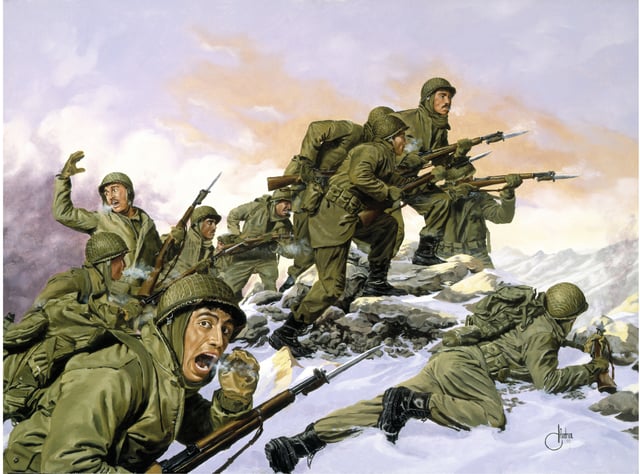
Painting of bayonet charge by the U.S. 65th Infantry Regiment against a Chinese division during the Korean War

American soldiers being taken prisoner in a Chinese counterattack on Triangle Hill.
Truman administration announced on January 5, 1950, that the United States would not become involved in any dispute about Taiwan Strait, and that he would not intervene in the event of an attack by the PRC,[73] but these plans were quickly undone when the Korean War began on 25 June with the invasion of the US-backed Republic of Korea by the communist Democratic People's Republic of Korea. A US-led international coalition of troops drove the North Korean forces from the South. In response to the Soviet-backed North Korean invasion of South Korea, the United Nations Security Council was convened and passed UNSC Resolution 82, declaring war on North Korea unanimously. The resolution was adopted mainly because the Soviet Union, a veto-wielding power, had been boycotting UN proceedings since January, in protest that the Republic of China and not the People's Republic of China held a permanent seat on the council.[74]
The American-led allied forces pushed the invading Korean People's Army back into North Korea, past the North-South border at the 38th parallel and began to approach the Yalu River on the China-North Korea border. Chinese warnings for the UN forces to not venture too close to their border were ignored, and in November 1950, a massive Chinese counterattack was launched. The Chinese army struck in the west along the Chongchon River and completely overran several South Korean divisions, successfully landing a heavy blow to the flank of the remaining forces. The defeat of the US Eighth Army resulted in the longest retreat of any American military unit in history.[75] Both sides sustained heavy casualties before the allied forces were able to push Chinese forces back, near the original division. In late March 1951, after the Chinese army had moved large numbers of new forces near the Korean border, US bomb loading pits at Kadena Air Base in Okinawa were made operational. On April 5, the US Joint Chiefs of Staff released orders for immediate retaliatory attacks using nuclear weapons against Manchurian bases to prevent new Chinese troops from entering the battles or bombing attacks originating from those bases. On the same day, Truman gave his approval for transfer of nine Mark IV nuclear capsules "to the Air Force's Ninth Bomb Group, the designated carrier of the weapons," signing an order to use them against Chinese and Korean targets. Two years of continued fighting ended in a stalemate, until the Korean Armistice Agreement was signed on July 27, 1953. Since then, a divided Korea has become an important factor in US-China relations. Also, the entry of China in the Korean War caused a major change in US policy from minimal support of the Nationalist government in Taiwan to Taiwan as protected by the United States.
Vietnam War
The People's Republic of China provided resources and training to North Vietnam, and in the summer of 1962, Chairman Mao Zedong agreed to supply Hanoi with 90,000 rifles and guns free of charge. After the launch of the America's Operation "Rolling Thunder", China sent anti-aircraft units and engineering battalions to North Vietnam to repair the damage caused by American bombing, rebuild roads and railroads, and perform other engineering work, freeing additional hundreds of thousands North Vietnamese army units for combat in American supported South Vietnam. The United States lost 58,159 troops in the Vietnam War.
The Chinese presence in North Vietnam was well known to US officials, and can explain a number of factors surrounding American strategy in the conflict. In particular, President Johnson and Secretary of Defense Robert McNamara ruled out the possibility of a ground invasion of North Vietnam early on, for fear of repeating the Korean War but now with a thermonuclear-armed China. However, it is unclear exactly what Beijing's reaction to a US invasion of North Vietnam would have been—Mao Zedong reportedly told journalist Edgar Snow in 1965 that China had no intention of fighting to save the Hanoi regime and would not engage the US military unless it crossed into Chinese territory. On other occasions, Mao expressed confidence that the People's Liberation Army could take on the US again, much like it did in Korea. Whatever Chinese plans might have been, the Johnson Administration was unwilling to tempt fate and so ground troops never crossed into North Vietnam.
Relations frozen
The United States continued to work to prevent the PRC from taking China's seat in the United Nations and encouraged its allies not to deal with the PRC. The United States placed an embargo on trading with the PRC, and encouraged allies to follow it. The PRC developed nuclear weapons in 1964 and, as later declassified documents revealed, President Lyndon B. Johnson considered preemptive attacks to halt its nuclear program. He ultimately decided the measure carried too much risk and it was abandoned.
For most of the 22 years between 1949 and 1971, Sino-US relations were uniformly hostile, with Mao Zedong frequently referring to the United States as "the most dangerous imperialist power", and the U.S. frequently attacked by Chinese propaganda. President Kennedy believed that US policy towards China was "nonsensical", and he considered reestablishing diplomatic ties in his second term. However, Kennedy's assassination in late 1963, followed by the Vietnam War and Cultural Revolution, ended any possibility of normalized relations with Beijing for years.
The Cultural Revolution brought about near-complete isolation of China from the outside world and vocal denunciations of both U.S. imperialism and Soviet revisionism.
Beginning in 1967, the Foreign Claims Settlement Commission established the China Claims Program, in which American citizens could denominate the sum total of their lost assets and property following the Communist seizure of foreign property in 1950. American companies were reluctant to invest in China despite (future Chairman) Deng Xiaoping's reassurances of a stable business environment.[77]
Rapprochement
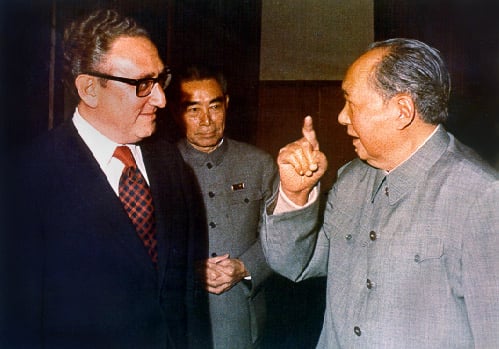
Henry Kissinger, shown here with Zhou Enlai and Mao Zedong, made two secret trips to the PRC in 1971 before Nixon's groundbreaking visit in 1972.

President Nixon and First Lady Pat Nixon walk with the American delegation and their Chinese hosts on the Great Wall of China.
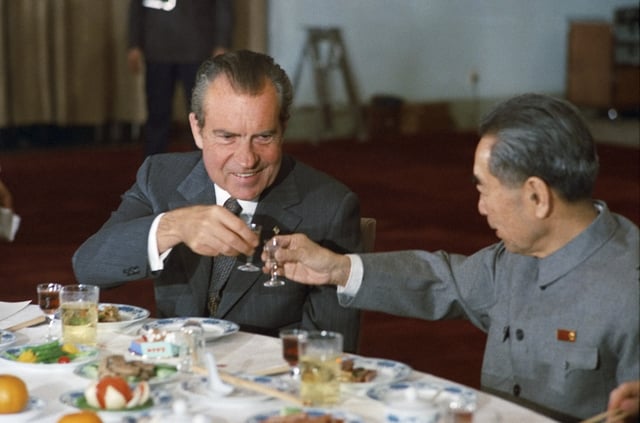
President Nixon and Chinese Premier Zhou Enlai toast during Nixon's 1972 visit to China
The end of the 1960s brought a period of transformation. For China, when American president Johnson decided to wind down the Vietnam war in 1968, it gave China an impression that the US had no interest of expanding in Asia anymore while the USSR became a more serious threat as it intervened in Czechoslovakia to displace a communist government and might well interfere in China.[78]
This became an especially important concern for the People's Republic of China after the Sino-Soviet border conflict of 1969. The PRC was diplomatically isolated and the leadership came to believe that improved relations with the United States would be a useful counterbalance to the Soviet threat. Zhou Enlai, the Premier of China, was at the forefront of this effort with the committed backing of Chairman Mao Zedong. In 1969, the United States initiated measures to relax trade restrictions and other impediments to bilateral contact, to which China responded. However, this rapprochement process was stalled by the Vietnam War where China was supporting the enemies of the United States. Communication between Chinese and American leaders, however, was conducted through Romania, Pakistan[79] and Poland as intermediaries.
In the United States, academics such as John K. Fairbank and A. Doak Barnett pointed to the need to deal realistically with the Beijing government, while organizations such as the National Committee on United States–China Relations sponsored debates to promote public awareness. Many saw the specter of Communist China behind communist movements in Vietnam, Cambodia, and Laos, but a growing number concluded that if the PRC would align with the US it would mean a major redistribution of global power against the Soviets. Mainland China's market of nearly one billion consumers appealed to American business. Senator J. William Fulbright, Chair of the Senate Foreign Relations Committee, held a series of hearings on the matter.[80]
Richard M. Nixon mentioned in his inaugural address that the two countries were entering an era of negotiation after an era of confrontation. Although Nixon during his 1960 presidential campaign had vociferously supported Chiang Kai-Shek, by the second half of the decade, he increasingly began to speak of there "being no reason to leave China angry and isolated". Nixon's election as president in 1968 was initially met with hostility by Beijing—an editorial in the People's Daily denounced him as "a chieftain whom the capitalist world had turned to out of desperation".[81] Nixon believed it was in the American national interest to forge a relationship with China, even though there were enormous differences between the two countries.[82] He was assisted in this by his National Security Advisor Henry Kissinger. Domestic politics also entered into Nixon's thinking, as the boost from a successful courting of the PRC could help him in the 1972 American presidential election. He also worried that one of the Democrats would preempt him and go to the PRC before he had the opportunity.
In 1971, an unexpectedly friendly encounter between the American and Chinese ping-pong athletes called Glenn Cowan and Zhuang Zedong in Japan opened the way for a visit to China, which Chairman Mao personally approved.[83] In April 1971, the athletes became the first Americans to officially visit China since the communist takeover. The smooth acceptance of this so-called "ping-pong diplomacy" gave confidence to both sides. In July 1971, Henry Kissinger feigned illness while on a trip to Pakistan and did not appear in public for a day. He was actually on a top-secret mission to Beijing to negotiate with Chinese Premier Zhou Enlai.
Kissinger and his aides did not receive a warm welcome in Beijing, and the hotel they stayed in was equipped with pamphlets excoriating US imperialism. However, the meeting with Zhou Enlai was productive, and the Chinese premier expressed his hope for improved Sino-US relations. He commented that the US had intentionally isolated China, not vice versa, and any initiative to restore diplomatic ties had to come from the American side. Zhou spoke of the late President Kennedy's plans to restore relations with China and told Kissinger "We are willing to wait as long as we need to. If these negotiations fail, in time another Kennedy or another Nixon will come along."[84]
On July 15, 1971, President Richard Nixon revealed the mission to the world and that he had accepted an invitation to visit the PRC.[85]
This announcement[86] caused immediate shock around the world. In the United States, some hard-line anti-communists (most notably Arizona Senator Barry Goldwater) denounced the decision, but most public opinion supported the move and Nixon saw the jump in the polls he had been hoping for. Since Nixon had sterling anti-communist credentials he was all but immune to being called "soft on communism." Nixon and his aides wanted to ensure that press coverage offered dramatic imagery.[87] Nixon was particularly eager for strong news coverage.
Within the PRC there was also opposition from left-wing elements. This effort was allegedly led by Lin Biao, head of the military, who died in a mysterious plane crash over Mongolia while trying to defect to the Soviet Union. His death silenced most internal dissent over the visit.
Internationally, reactions varied. In the communist world, the Soviets were very concerned that two major enemies seemed to have resolved their differences, and the new world alignment contributed significantly to the policy of détente. Romania's president Nicolae Ceaușescu praised the US initiative as a "move for world peace". Several communist regimes, including Cuba, Albania, and North Vietnam, accused China of "capitulationism to the imperialists". North Korea proclaimed that it was the reverse and that the US had been forced to capitulate to China, having failed to isolate it.
America's European allies and Canada were pleased by the initiative, especially since many of them had already recognized the PRC. In Asia, the reaction was far more mixed. Japan was annoyed that it had not been told of the announcement until fifteen minutes before it had been made, and feared that the Americans were abandoning them in favor of the PRC. A short time later, Japan also recognized the PRC and committed to substantial trade with the continental power. South Korea and South Vietnam were both concerned that peace between the United States and the PRC could mean an end to American support for them against their communist enemies. Throughout the period of rapprochement, both countries had to be regularly assured that they would not be abandoned.
From February 21 to February 28, 1972, President Nixon traveled to Beijing, Hangzhou, and Shanghai. At the conclusion of his trip, the US and the PRC issued the Shanghai Communiqué, a statement of their respective foreign policy views. In the Communiqué, both nations pledged to work toward the full normalization of diplomatic relations. This did not lead to immediate recognition of the People's Republic of China but 'liaison offices' were established in Beijing and Washington.[88] The US acknowledged the PRC position that all Chinese on both sides of the Taiwan Strait maintain that there is only one China and that Taiwan is part of China. The statement enabled the US and PRC to temporarily set aside the issue of Taiwan and open trade and communication. Also, the US and China both agreed to take action against 'any country' that is to establish 'hegemony' in the Asia-Pacific. On several issues, such as the ongoing conflicts in Korea, Vietnam, and Israel, the US and China were unable to reach a common understanding.[88]
Most major anti-US propaganda disappeared in China after the Nixon visit; although there was still occasional criticism of US imperialism, the Soviet Union had definitively become China's arch-foe in the 1970s.
The rapprochement with the United States benefited the PRC immensely and greatly increased its security for the rest of the Cold War. It has been argued that the United States, on the other hand, saw fewer benefits than it had hoped for, inasmuch as China continued to back America's enemies in Hanoi and Pyongyang. Eventually, however, the PRC's suspicion of Vietnam's motives led to a break in Sino-Vietnamese cooperation and, upon the Vietnamese invasion of Cambodia in 1979, the Sino-Vietnamese War. Both China and the United States backed combatants in Africa against Soviet and Cuban-supported movements. The economic benefits of normalization were slow as it would take decades for American products to penetrate the vast Chinese market. While Nixon's China policy is regarded by many as the highlight of his presidency, others such as William Bundy have argued that it provided very little benefit to the United States.
Liaison Office (1973–1978)

President Gerald Ford makes remarks at a Reciprocal Dinner in Beijing on December 4, 1975.
In May 1973, in an effort to build toward formal diplomatic relations, the US and the PRC established the United States Liaison Office (USLO) in Beijing and a counterpart PRC office in Washington. In 1973 to 1978, such distinguished Americans as David K. E. Bruce, George H. W. Bush, Thomas S. Gates, Jr., and Leonard Woodcock served as chiefs of the USLO with the personal rank of ambassador. China made clear that it considered the Soviet Union its chief adversary, and urged the United States to be powerful, thereby distracting Moscow. Liaison officer George Bush concluded, "China keeps wanting us to be strong, wanting us to defend Europe, wanting us to increase our defense budgets, etc."[89] Bush concluded that American engagement was essential to support markets, allies, and stability in Asia and around the world.[90]
President Gerald Ford visited the PRC in 1975 and reaffirmed American interest in normalizing relations with Beijing. Shortly after taking office in 1977, President Jimmy Carter again reaffirmed the goals of the Shanghai Communiqué. Secretary of State Cyrus Vance, Carter's National Security Advisor Zbigniew Brzezinski, and senior staff member of the National Security Council Michel Oksenberg encouraged Carter to seek full diplomatic and trade relations with China. Although Brzezinski sought to quickly establish a security relationship with Beijing to counter the Soviet Union, Carter sided with Vance in believing that such a deal would threaten existing U.S.-Soviet relations, including the SALT II negotiations. Thus, the administration decided to cautiously pursue political normalization and not military relations.[91] Vance, Brzezinski, and Oksenberg traveled to Beijing in early 1978 to work with Leonard Woodcock, then head of the liaison office, to lay the groundwork to do so. The United States and the People's Republic of China announced on December 15, 1978 that the two governments would establish diplomatic relations on January 1, 1979.
Normalization

Jimmy Carter, Zbigniew Brzezinski, and other U.S. officials meet in the White House Cabinet Room with Deng Xiaoping, 29 January 1979
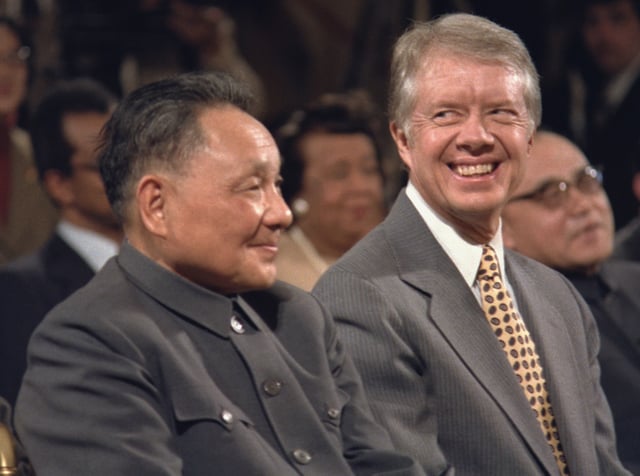
Deng Xiaoping with US President Jimmy Carter
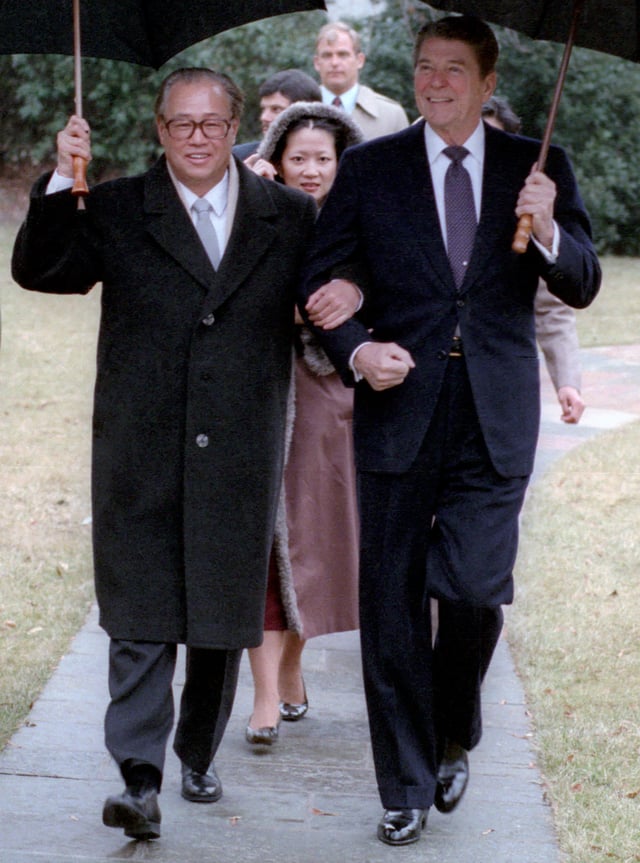
President Ronald Reagan walking with Premier Zhao Ziyang during his visit to the White House on 10 January 1984.
In the Joint Communiqué on the Establishment of Diplomatic Relations, dated January 1, 1979, the United States transferred diplomatic recognition from Taipei to Beijing. The US reiterated the Shanghai Communiqué's acknowledgment of the Chinese position that there is only one China and that Taiwan is a part of China; Beijing acknowledged that the American people would continue to carry on commercial, cultural, and other unofficial contacts with the people of Taiwan.[92]
Much like the Nixon visit to Beijing six years earlier, the formal establishment of Sino-US ties met with a mixed response from many countries. Taiwan, although fully expecting this step, nonetheless expressed disappointment at having not been consulted first. The reaction of the communist world was similar to 1972, with the Soviet Union and its allies in Eastern Europe mostly being noncommittal, Romania welcoming the move, and Cuba and Albania being strongly against it. North Korea issued a statement congratulating "our brotherly neighbors for ending long-hostile relations with the US".
Vice Premier Deng Xiaoping's January 1979 visit to Washington initiated a series of important, high-level exchanges which continued until the spring of 1989. This resulted in many bilateral agreements, especially in the fields of scientific, technological, and cultural interchange, as well as trade relations. Since early 1979, the United States and the PRC have initiated hundreds of joint research projects and cooperative programs under the Agreement on Cooperation in Science and Technology, the largest bilateral program.[93]
On March 1, 1979, the two countries formally established embassies in each other's capitals. In 1979, outstanding private claims were resolved and a bilateral trade agreement was completed. Vice President Walter Mondale reciprocated Vice Premier Deng's visit with an August 1979 trip to China. This visit led to agreements in September 1980 on maritime affairs, civil aviation links, and textile matters, as well as a bilateral consular convention.
The threats of the Soviet invasion of Afghanistan and Vietnamese invasion of Cambodia were major factors that brought Washington and Beijing closer than ever before.[94] Sino-US military cooperation began in 1979; American arms sales to China were initiated, and in 1981 it was revealed that a joint Sino-US listening post had been operated in Xinjiang, near the Soviet border.
Chinese demands for advanced technology from the US were not always met, in part due to opposition from Congressmen who either distrusted technology transfer to a communist nation out of principle, or concern that there was no guarantee that such technology would not end up in the hands of unfriendly third parties. In 1983, the US State Department changed its classification of China to "a friendly, developing nation", thereby increasing the amount of technology and armaments that could be sold. The skepticism of some US Congressmen was not entirely unmerited as China during the 1980s continued to sell arms to Iran and other states that were openly hostile to American interests.
As a consequence of high-level and working-level contacts initiated in 1980, New York City and Beijing become sister cities, US dialogue with the PRC broadened to cover a wide range of issues, including global and regional strategic problems, political-military questions, including arms control, UN, and other multilateral organization affairs, and international narcotics matters.[95]
High-level exchanges continued to be a significant means for developing US–PRC relations in the 1980s. President Ronald Reagan and Premier Zhao Ziyang made reciprocal visits in 1984. Reagan's visit to Beijing went well, however a speech he made criticizing the Soviet Union and praising capitalism, democracy, and freedom of religion was not aired on Chinese state TV. In July 1985, Chinese President Li Xiannian traveled to the United States, the first such visit by a PRC head of state. Vice President Bush visited the PRC in October 1985 and opened the US Consulate General in Chengdu, the US's fourth consular post in the PRC. Further exchanges of cabinet-level officials occurred between 1985 and 1989, capped by President Bush's visit to Beijing in February 1989.
Shortly after being elected president in 1980, Ronald Reagan made a speech criticizing the PRC and welcoming restoration of ties with Taiwan. These remarks aroused initial panic in Beijing, but Reagan's advisers quickly apologized for his comments, and the president-elect soon retracted them.
Reagan's first two years in office saw some deterioration in Sino-US relations due to the president's vociferous anti-communism, as well as the inability of the two nations to come to a common understanding over the Korean standoff, the Israel–Palestine conflict, or the Falkland War. In 1982, Deng Xiaoping, in a reiteration of Mao Zedong's "Three Worlds" theory, criticized both the US and Soviet Union for imperialism. In 1983, there were quarrels over a Chinese tennis player, Hu Na, who defected to the US, and over an incident where an Olympic parade float in New York City displayed the flag of Taiwan rather than the PRC's flag.
In the period before the Tiananmen Square protests of 1989, a growing number of cultural exchange activities gave the American and Chinese peoples broad exposure to each other's cultural, artistic, and educational achievements. Numerous mainland Chinese professional and official delegations visited the United States each month. Many of these exchanges continued after the suppression of the Tiananmen protests.[96]
Taiwan issue
Since the renewal of Sino-American relations in early 1979, the Taiwan issue remained a major source of contention. After the announcement of the intention to establish diplomatic relations with Mainland China (PRC) on 15 December 1978, the Republic of China (Taiwan) immediately condemned the United States, leading to rampant protests in both Taiwan and in the US.[97] In April 1979, the US Congress signed into law the Taiwan Relations Act,[98] permitting unofficial relations with Taiwan to flourish, on the one hand, yet the right of the US to provide Taiwan with arms of a defensive character, on the other. The expanding relationship that followed normalization was threatened in 1981 by PRC objections to the level of US arms sales to the Republic of China on Taiwan. Secretary of State Alexander Haig visited China in June 1981 in an effort to resolve Chinese concerns about America's unofficial relations with Taiwan. Vice President Bush visited the PRC in May 1982. Eight months of negotiations produced the US-PRC Joint Communiqué of August 17, 1982. In this third communiqué, the US stated its intention to gradually reduce the level of arms sales to the Republic of China, and the PRC described as a fundamental policy their effort to strive for a peaceful resolution to the Taiwan question. China's Ambassador to Washington, in an interview with CGTN in April 2018, is quoted as saying that Sino-American relations hinge largely upon the US-PRC Joint Communiqué signed between the two parties and where the USA had agreed not to challenge the PRC's sovereignty over the island of Taiwan, but to respect China's "anti-secession law," until such time that Taiwan will be reunified with the Mainland.[99] However, with the coming of the Trump administration, contention over this issue intensified; president Trump became the first sitting US president since 1979 and Jimmy Carter to have any formal political or diplomatic contacts when he decided to receive a phone call from president Tsai Ing Wen, he has expanded the duties of the US' de facto embassy in Taipei- American Institute in Taiwan - by adding more security personnel, and has overseen increasing non-diplomatic visits of Tsai ing Wen and Congressmen to each others countries/regions. In addition, American warships have reportedly crossed the Taiwan straight and has increased military drills with it, which mainland China views as a direct threat to its sovereignty. The administration has also went as far as to warn Solomon Islands not to switch recognition to the mainland china from Taiwan as part of a bid to preserve its shrinking number of allies worldwide. [100] [101] [102] [103] [104]
Tiananmen protests to 9/11 attacks (1989–2001)
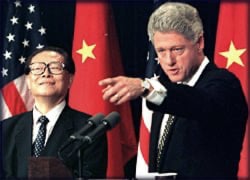
Bill Clinton and Jiang Zemin holding a joint press conference at the White House, October 29, 1997.
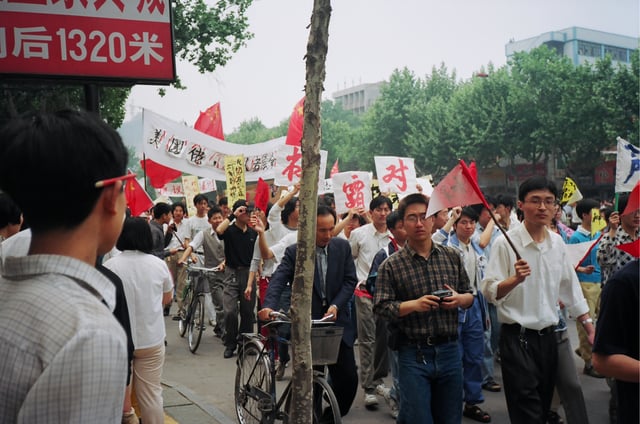
Anti-American protests in Nanjing following the U.S. bombing of the Chinese embassy in Belgrade, 1999
Following China's violent suppression of political protests in June 1989, the US and other governments enacted a number of measures against China's violation of human rights. The US suspended high-level official exchanges with the PRC and weapons exports from the US to the PRC. The US also imposed a number of economic sanctions. In the summer of 1990, at the G7 Houston summit, the West called for renewed political and economic reforms in mainland China, particularly in the field of human rights.[105]
Tiananmen event disrupted the US-China trade relationship, and US investors' interest in mainland China dropped dramatically. Tourist traffic fell off sharply.[106] The Bush administration denounced the repression and suspended certain trade and investment programs on June 5 and 20, 1989, however Congress was responsible for imposing many of these actions, and the White House itself took a far less critical attitude of Beijing, repeatedly expressing hope that the two countries could maintain normalized relations.[107] Some sanctions were legislated while others were executive actions. Examples include:
The US Trade and Development Agency (TDA): new activities in mainland China were suspended from June 1989 until January 2001, when President Bill Clinton lifted this suspension.
Overseas Private Insurance Corporation (OPIC): new activities have been suspended since June 1989.
Development Bank Lending/International Monetary Fund (IMF) Credits: the United States does not support development bank lending and will not support IMF credits to the PRC except for projects that address basic human needs.
Munitions List Exports: subject to certain exceptions, no licenses may be issued for the export of any defense article on the US Munitions List. This restriction may be waived upon a presidential national interest determination.
Arms Imports – import of defense articles from the PRC was banned after the imposition of the ban on arms exports to the PRC. The import ban was subsequently waived by the Administration and reimposed on May 26, 1994. It covers all items on the BATFE's Munitions Import List. During this critical period, J. Stapleton Roy, a career US Foreign Service Officer, served as ambassador to Beijing.[108]
After Tiananmen Square, Sino-US relations deteriorated sharply, falling to their worst since the 1960s, with Beijing accusing the US of "a decades-long conspiracy to subvert Chinese socialism". The 2-1/2 years from 1989 to 1992 also witnessed a revival of hard-line Maoist ideologies and increased paranoia by the PRC as communist regimes collapsed in Eastern Europe. Nonetheless, China continued to seek foreign business and investment.
Sino-US military ties and arms sales were abruptly terminated in 1989 and as of 2017 have never been restored.
In 1993, the U.S. Navy stopped a Chinese container ship, the Yinhe, en-route to Kuwait alleging it was carrying precursors of chemical weapons for Iran, eventually forcing an inspection in Saudi Arabia. No precursors of chemical weapons were found, just paint. This incident was viewed in China as international bullying by the United States, and significantly contributed to anti-U.S. sentiments amongst the population.[109]
In 1996, the PRC conducted military exercises in the Taiwan Strait in an apparent effort to intimidate the Republic of China electorate before the pending presidential elections, triggering the Third Taiwan Strait Crisis. The United States dispatched two aircraft carrier battle groups to the region. Subsequently, tensions in the Taiwan Strait diminished and relations between the US and the PRC improved, with increased high-level exchanges and progress on numerous bilateral issues, including human rights, nuclear proliferation, and trade. China's leader Jiang Zemin visited the United States in the fall of 1997, the first state visit to the US by a PRC president since 1985 and the first visit to the US by a paramount leader since 1979. In connection with that visit, the two sides came to a consensus on implementation of their 1985 agreement on Peaceful Nuclear Cooperation, as well as a number of other issues.[110] President Clinton visited the PRC in June 1998. He traveled extensively in mainland China, and had direct interaction with the Chinese people, including live speeches and a radio show which allowed the President to convey a sense of American ideals and values. President Clinton was criticized by some, however, for failing to pay adequate attention to human rights abuses in mainland China.[111]
Relations were damaged for a time by the United States bombing of the Chinese embassy in Belgrade in May 1999, which was stated by the White House to be miscoordination between intelligence and the military, although which some Chinese believed to be deliberate. In any case, Beijing for several days was rocked by massive anti-US demonstrations. By the end of 1999, relations began to gradually improve. In October 1999, the two countries reached an agreement on compensation for families of those who were victims, as well as payments for damages to respective diplomatic properties in Belgrade and China. Sino-US relations in 1999 were also damaged by accusations that a Chinese-American scientist at the Los Alamos National Laboratory had given US nuclear secrets to Beijing.
In April 2001, a PRC J-8 fighter jet collided with a US EP-3 reconnaissance aircraft flying south of the PRC in what became known as the Hainan Island incident. The EP-3 was able to make an emergency landing on PRC's Hainan Island despite extensive damage; the PRC aircraft crashed with the loss of its pilot, Wang Wei. The crew were detained by the PLA after destroying all classified documents pertaining to the aircraft's operation. It was widely believed that the EP-3 recon aircraft was conducting a spying mission on the PLA before the collision, which however took place over international waters. Following extensive negotiations resulting in the "letter of the two sorries," the crew of the EP-3 was released from imprisonment and allowed to leave the PRC eleven days later. The US aircraft was returned by Beijing three months later in pieces, after which the relationship between the US and the PRC gradually improved once more.
George W. Bush's tenure (2001–2009)
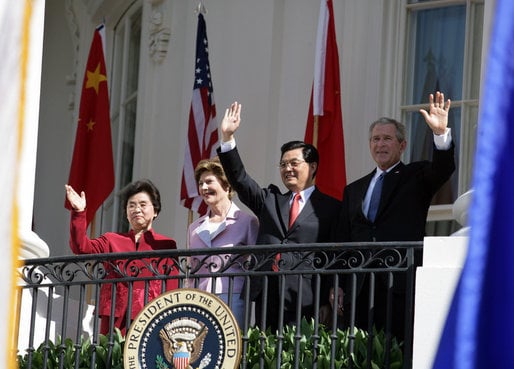
Presidents George W. Bush, and Hu Jintao with first ladies Laura Bush, and Liu Yongqing wave from the White House in April 2006.
Sino–American relations improved following the September 11 terrorist attacks. Two PRC citizens died in the attacks on the World Trade Center.[112] Chinese companies and individuals sent expressions of condolences to their American counterparts. The PRC, itself troubled by Muslim separatists in Xinjiang, offered strong public support for the War on Terror in APEC China 2001. The PRC voted in favor of UNSCR 1373, publicly supported the coalition campaign in Afghanistan,[113] and contributed $150 million of bilateral assistance to Afghan reconstruction following the defeat of the Taliban. Shortly after 9/11, the US and PRC also commenced a counterterrorism dialogue. The third round of that dialogue was held in Beijing in February 2003.
In the United States, the terrorist attacks greatly changed the nature of discourse. It was no longer plausible to argue, as the Blue Team had earlier asserted, that the PRC was the primary security threat to the United States, and the need to focus on the Middle East and the War on Terror made the avoidance of potential distractions in East Asia a priority for the United States.
There were initial fears among the PRC leadership that the war on terrorism would lead to an anti-PRC effort by the US, especially as the US began establishing bases in Central Asian countries like Uzbekistan and Tajikistan and renewed efforts against Iraq. Because of setbacks in America's Iraq campaign, these fears have largely subsided. The application of American power in Iraq and continuing efforts by the United States to cooperate with the PRC has significantly reduced the popular anti-Americanism that had developed in the mid-1990s.
The PRC and the US have also worked closely on regional issues, including those pertaining to North Korea and its nuclear weapons program. The People's Republic of China has stressed its opposition to North Korea's decision to withdraw from the Treaty on the Non-Proliferation of Nuclear Weapons, its concerns over North Korea's nuclear capabilities, and its desire for a non-nuclear Korean Peninsula. It also voted to refer North Korea's noncompliance with its International Atomic Energy Agency obligations to the UN Security Council.
Taiwan remains a volatile issue, but one that remains under control. The United States policy toward Taiwan has involved emphasizing the Four Noes and One Without. On occasion the United States has rebuked Republic of China President Chen Shui-bian for provocative pro-independence rhetoric. However, in 2005, the PRC passed the Anti-Secession Law which stated that the PRC would be prepared to resort to "non-peaceful means" if Taiwan declared formal independence. Many critics of the PRC, such as the Blue Team, argue that the PRC was trying to take advantage of the US war in Iraq to assert its claims on Republic of China's territory. In 2008, Taiwan voters elected Ma Ying-jeou. Ma, representing the Kuomintang, campaigned on a platform that included rapprochement with mainland China. His election has significant implications for the future of cross-strait relations.[114]
Obama's tenure (2009–2017)

Chinese Vice Premier Wang Qishan, center, holds the autographed basketball given to him by President Barack Obama following their Oval Office meeting Tuesday, July 28, 2009, to discuss the outcomes of the first US–China Strategic and Economic Dialogue. Looking on at left is Chinese State Councilor Dai Bingguo.[117]

Obama meets with Wen Jiabao and members of the Chinese delegation after a bilateral meeting at the United Nations in New York City.
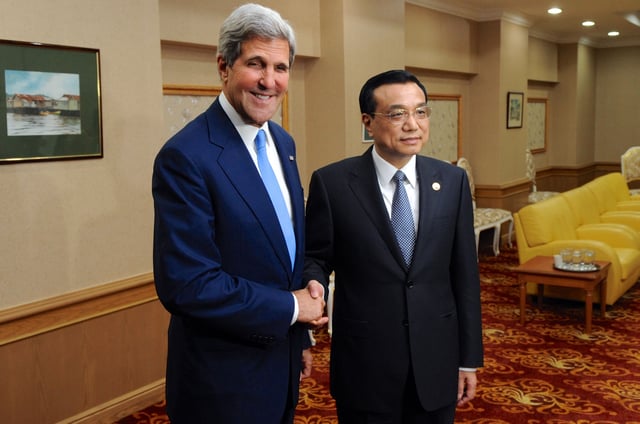
U.S. Secretary of State John Kerry speaks with Chinese Premier Li Keqiang, October 9, 2013.

U.S. Secretary of State John Kerry and Vice President Joe Biden with Chinese leader Xi Jinping, September 25, 2015.
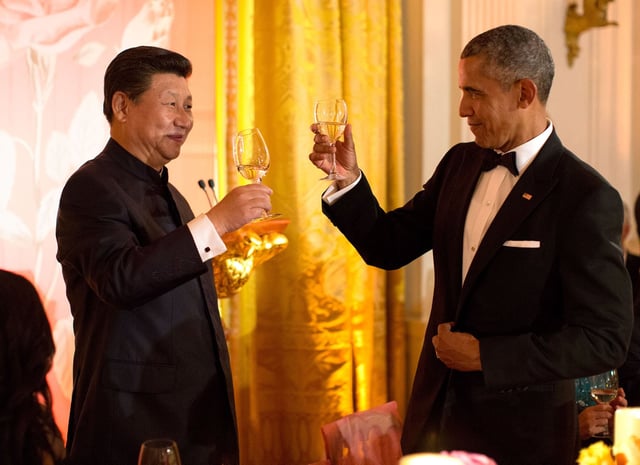
President Barack Obama and Chinese President Xi Jinping in September 2015
The 2008 US presidential election centered on issues of war and economic recession, but candidates Barack Obama and John McCain also spoke extensively regarding US policy toward China.[118] Both favored cooperation with China on major issues, but they differed with regard to trade policy. Obama expressed concern that the value of China's currency was being deliberately set low to benefit China's exporters. McCain argued that free trade was crucial and was having a transformative effect in China. Still, McCain noted that while China might have shared interests with the US, it did not share American values.[119]
Barack Obama's presidency has fostered hopes for increased co-operation and heightened levels of friendship between the two nations. On November 8, 2008, Hu Jintao and Barack Obama shared a phone conversation in which the Chinese President congratulated Obama on his election victory. During the conversation both parties agreed that the development of US-China relations is not only in the interest of both nations, but also in the interests of the world.[120][121][122]
Other organizations within China also held positive reactions to the election of Barack Obama, particularly with his commitment to revising American climate change policy. Greenpeace published an article detailing how Obama's victory would spell positive change for investment in the green jobs sector as part of a response to the financial crisis gripping the world at the time of Obama's inauguration.[123] A number of organizations, including the US Departments of Energy and Commerce, NGOs such as the Council on Foreign Relations and the Brookings Institution, and universities, have been working with Chinese counterparts to discuss ways to address climate change. Both US and Chinese governments have addressed the economic downturn with massive stimulus initiatives. The Chinese have expressed concern that "Buy American" components of the US plan discriminate against foreign producers, including those in China.[124]
As the two most influential and powerful countries in the world, there have been increasingly strong suggestions within American political circles of creating a G-2 (Chimerica) relationship for the United States and China to work out solutions to global problems together.[125]
The Strategic Economic Dialogue initiated by then-US President Bush and Chinese President Hu and led by US Treasury Secretary Henry Paulson and Chinese Vice Premier Wu Yi in 2006 has been broadened by the Obama administration. Now called the U.S.–China Strategic and Economic Dialogue, it is led by US Secretary of State Hillary Clinton and US Secretary of the Treasury Timothy Geithner for the United States and Vice Premier Wang Qishan and Chinese State Councilor Dai Bingguo for China. The focus of the first set of meetings in July 2009 was in response to the economic crisis, finding ways to cooperate to stem global warming and addressing issues such as the proliferation of nuclear weapons and humanitarian crises.[126]
US President Barack Obama visited China on November 15–18, 2009 to discuss economic worries, concerns over nuclear weapon proliferation, and the need for action against climate change.[127] The USC US-China Institute produced a digest of press comments on this visit and on earlier presidential trips.[128]
In January 2010, the US proposed a $6.4 billion arms sale to the Republic of China. In response, the PRC threatened to impose sanctions on US companies supplying arms to Taiwan and suspend cooperation on certain regional and international issues.[129]
On February 19, 2010, President Obama met with the Dalai Lama, accused by China of "fomenting unrest in Tibet." After the meeting, China summoned the US ambassador to China, Jon Huntsman,[130] but Time has described the Chinese reaction as "muted," speculating that it could be because "the meeting came during the Chinese New Year... when most officials are on leave." Some activists criticized Obama for the relatively low profile of the visit.[131]
In March 2012, China suddenly began cutting back its purchases of oil from Iran, along with some signs on sensitive security issues like Syria and North Korea, showed some coordination with the Obama administration.[134]
In March 2013, the US and China agreed to impose stricter sanctions on North Korea for conducting nuclear tests, which sets the stage for UN Security Council vote. Such accord might signal a new level of cooperation between the US and China.[135]
In an effort to build a "new model" of relations, President Obama met President Xi Jinping for two days of meetings, between 6 June and 8 June 2013, at the Sunnylands estate in Rancho Mirage, California.[136] The summit was considered "the most important meeting between an American president and a Chinese Communist leader in 40 years, since President Nixon and Chairman Mao," according to Joseph Nye, a political scientist at Harvard University.[137] The leaders concretely agreed to combat climate change and also found strong mutual interest in curtailing North Korea's nuclear program.[137] However, the leaders remained sharply divided over cyber espionage and U.S. arms sales to Taiwan. Xi was dismissive of American complaints about cyber security.[138] Tom Donilon, the outgoing U.S. National Security Adviser, stated that cyber security "is now at the center of the relationship," adding that if China's leaders were unaware of this fact, they know now.[138]
Relations between the military leadership of the two nations improved in 2013. General Qi said that over the long term the shared interests of the two would outweigh their differences.
In May 2015, U.S. Secretary of Defense Ashton Carter warned China to halt its rapid island-building in the South China Sea.[141]
President Obama hosted President Xi Jinping of the People's Republic of China for a bilateral meeting on the margins of the Nuclear Security Summit on March 31, 2016.[142]
Trump's presidency (2017–)
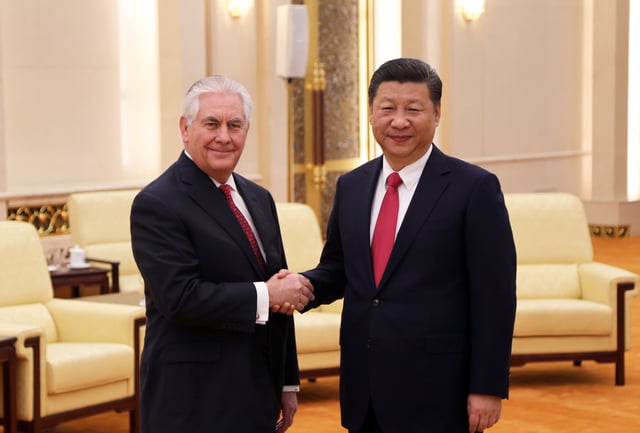
Secretary of State Rex Tillerson shakes hands with President Xi Jinping upon arrival in Beijing, March 19, 2017.

Secretary of State Mike Pompeo shakes hands with President Xi Jinping upon arrival in Beijing, June 14, 2018.
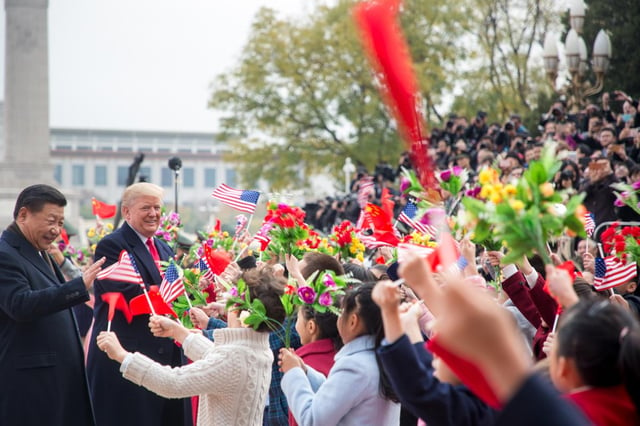
President Donald Trump arrives in China in November 2017
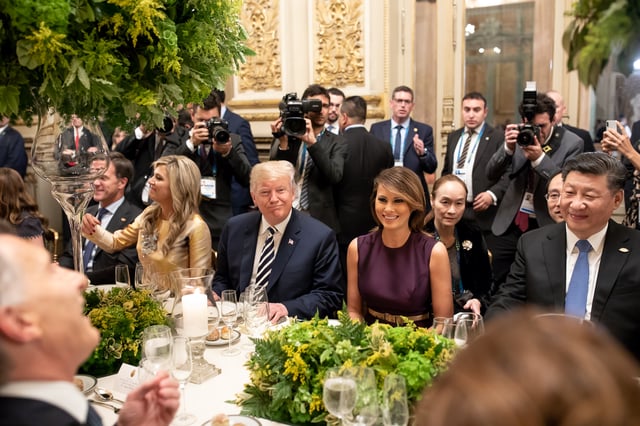
Trump and Xi Jinping at the G20 Buenos Aires summit in November 2018

U.S. lawmakers from both parties have voiced their support for pro-democracy Hong Kong protests in 2019
President-elect of the United States Donald Trump's telephone conversation with the president of Taiwan Tsai Ing-wen, on 2 December 2016, the first such contact with Taiwan by a U.S. president-elect or president since 1979, provoked the People's Republic of China to lodge a diplomatic protest ("stern representations").[143][144] Trump went on to clarify his move by telling the Fox News, "I fully understand the 'one China' policy, but I don't know why we have to be bound by a 'one China' policy unless we make a deal with China having to do with other things, including trade."[144]
On Donald Trump's inauguration day, an official from the People's Liberation Army wrote on the official website that the US's military build-up in Asia, and its push to arm South Korea with the THAAD missile-defense system were provocative "hot spots getting closer to ignition" and that the chances of war had become "more real".[145][146]
On 23 January, speaking about China's claims to sovereignty over the Spratly Islands in the South China Sea, White House spokesman Sean Spicer said, "It's a question of if those islands are in fact in international waters and not part of China proper, then yeah, we're going to make sure that we defend international territories from being taken over by one country."[147]
On 9 February, Trump spoke with China's leader Xi Jinping over the phone discussing a wide range of issues; Trump was said to have re-iterated the United States' commitment to the status quo 'one-China' policy.[149]
President Xi Jinping reiterated before President Trump, in a telephone conversation held between the two men on 3 July 2017, that "China-US relations have made great progress in recent days, but they have also been affected by some negative factors."[150] By "negative factors," Geng Shuang, a Chinese government spokesmen, explained in a televised briefing: "Under the pretext of navigational freedom, the American side once again sent military vessels into the Chinese territorial waters of Xisha (Paracel) Islands. It has violated Chinese and international law, infringed upon Chinese sovereignty, and disrupted order, peace and security of the relevant waters and put in jeopardy facilities and personnel on the relevant Chinese islands. It is a serious political and military provocation. The Chinese side is strongly dissatisfied with and firmly opposed to the relevant actions by the US."[150]
On 8 November 2017, President Trump visited Beijing as part of the Asian tour. The main theme of the meeting emphasized the issues regarding the de-nucleariziation on the Korean peninsula in addition to the stabilization of China–United States relations. President Trump reiterated the importance of trade development between the two countries and reaffirmed the American support for the One-China policy. However, according to the latest U.S. National Security Act from 18 December 2017, the ships of U.S. Navy can call at the ports of Taiwan. This fact breaks "One-China" law, consider the Chinese government. Chinese Ambassador to the US Lee Kexin said that "the day when any US warship will enter the port of Taiwan Kaohsiung, the CPLA forces will unite China".[151]
On 13 March 2018, the out-going US Secretary of State, Rex Tillerson, said: "Much work remains to establish a clear view of the nature of our future relationship with China, how shall we deal with one-another over the next fifty years, and ensure a period of prosperity for all of our peoples, free of conflict between two very powerful nations."[152]
China enforced punitive tariffs on 128 categories of American goods on April 1, 2018 in retaliation for the Trump Administration’s national-security levies on steel and aluminum imports the previous month.The Chinese Government's response is measured, affecting $3 billion in annual trade or about 2% of U.S. goods exports to China. By late September 2018, the Trump Administration had placed tariffs (25% tax increase) on $250 billion worth of Chinese goods, in an attempt to offset the trade imbalance between the two countries.
In what put additional strain on US-China relations, Huawei's Chief financial officer Meng Wanzhou, daughter of Huawei's founder Ren Zhengfei, was arrested in Canada on December 1, 2018 at the behest of U.S. authorities.[153] U.S. Senator Ben Sasse accused China of undermining U.S. national security interests, often "using private sector entities" to by-pass US sanctions against the sale of telecom equipment to Iran.[154]
According to political analyst, Andrew Leung, "China is perceived as the antagonist and rival of the United-States," and that China's rise is seen as a "threat to the world order underpinned by American dominance or American values."[155] He claimed, moreover, that the arrest of the CFO of Huawei on 1 Dec. 2018 corresponded with the suspicious death on that same day of a leading Chinese-national quantum physicist and venture capitalist at Stanford University, Professor Shou-Cheng Zhang, who was on a H-1B visa, giving rise to conspiracy theories. In August 2018, the U.S. government signed an update to legislation for the Committee on Foreign Investment in the U.S., broadening governmental scrutiny to vetting VC-backed, and especially Chinese state-funded, investments in U.S. tech startups.[156]
On July 11, 2019, in an interview with The Atlantic, the U.S. Deputy Secretary for the Middle East Michael Mulroy explained that the Department of Defense was concerned about China’s desire to erode U.S. military advantages, as well as China’s push for access and basing, use of economics to intimidate through the One Belt One Road initiative (which is a worldwide campaign of infrastructure investment) and technology and intellectual property theft, acquisition and penetration.[157] This was followed by U.S. Army General Mark Milley's testimony during his Senate confirmation hearing to be the next Chairman of the Joint Chiefs of Staff where he said that China was the United States' primary challenge and they were outspending the U.S. in research, development and procurement.[158]
By September of 2019, due to ongoing trade disputes between the United-States and China, China dropped from first-place to third, behind Mexico and Canada, as America's foremost trading partner.[159]
Rapid worsening of relations
Michael D. Swaine argued in 2019 that:
- The U.S.-China relationship is confronting its most daunting challenge in the forty years since the two countries established diplomatic ties. Current trends portend steadily worsening relations over the long term, with increasingly adverse consequences for all actors involved. Specifically, Beijing and Washington are transitioning from a sometimes contentious yet mutually beneficial relationship to an increasingly antagonistic, mutually destructive set of interactions. The often positive and optimistic forces, interests, and beliefs that sustained bilateral ties for decades are giving way to undue pessimism, hostility, and a zero-sum mindset in almost every area of engagement.[160]
According to two experts on US-China relations, Professor Rosemary Foot at Oxford University and Senior Lecturer Amy King at Australian National University, the consensus of experts is that:
- The relationship began to deteriorate in the second decade of the 21st century, and that the Trump administration has accelerated the deterioration. Explanations...have ranged over a large number of factors, all of which have played some role. Some relate to changes in official personnel in both the United States and China, others to the shifts and relative power between the two countries after the global financial crisis of 2007–2008, and yet others to China's greater determination to reform global governance institutions and to play more of a global leadership role.[161]
Foot and King emphasize China's aggressive efforts in developing cutting-edge technologies with significant military and commercial implications, while the United States sees the need to defend itself aggressively against technological theft.[162]
According to Hong Kong economics professor Lawrence J. Lau, a major cause of the deterioration is the growing battle between China and the U.S. for global economic and technological dominance. More generally, he argues, "It is also a reflection of the rise of populism, isolationism, nationalism and protectionism almost everywhere in the world, including in the US."[163]
Economic relations

Imports and exports between China and the United States. US census.gov data.

Foreign holders of U.S. Treasury securities (2009)
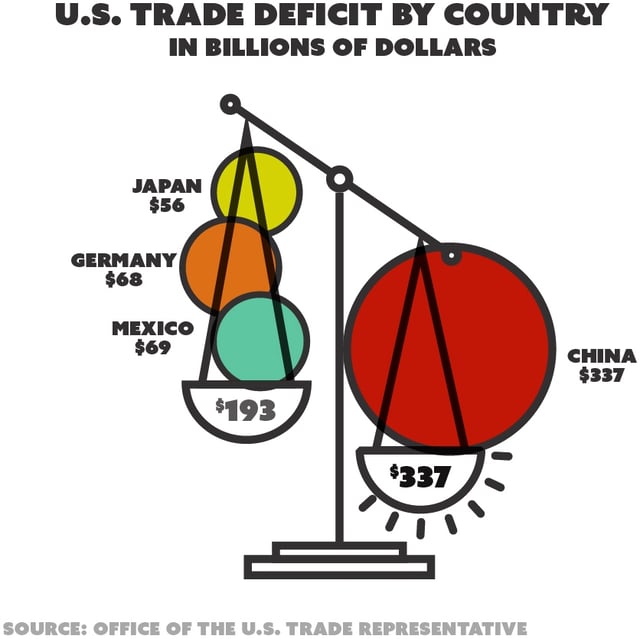
U.S. trade deficit (in billions, goods and services) by country in 2017

The first round of the U.S.–China Strategic and Economic Dialogue was held in Washington, D.C., from 27 to 28 July 2009

Countries by total wealth (billions USD), Credit Suisse 2018
In 1991, China only accounted for 1% of total imports to the United States.[164] For many years, China was the most important country which required an annual waiver to maintain free trade status. The waiver for the PRC had been in effect since 1980. Every year between 1989 and 1999, legislation was introduced in Congress to disapprove the President's waiver. The legislation had sought to tie free trade with China to meeting certain human rights conditions that go beyond freedom of emigration. All such attempted legislation failed to pass. The requirement of an annual waiver was inconsistent with the rules of the World Trade Organization, and for the PRC to join the WTO, Congressional action was needed to grant permanent normal trade relations (PNTR) to China. This was accomplished in 2000 (United States–China Relations Act of 2000), allowing China to join WTO in 2001.[165][166][167] China's most favoured nation (MFN) status was made permanent on December 27, 2001.[168]
Since the entry of China into the WTO in December 2001, the decline in U.S. manufacturing jobs has accelerated (the China shock).[169][170] The Economic Policy Institute estimated that the trade deficit with China cost about 2.7 million jobs between 2001 and 2011, including manufacturing and other industries.[171]
The PRC and the US resumed trade relations in 1972 and 1973. Direct investment by the US in mainland China covers a wide range of manufacturing sectors, several large hotel projects, restaurant chains, and petrochemicals. US companies have entered agreements establishing more than 20,000 equity joint ventures, contractual joint ventures, and wholly foreign-owned enterprises in mainland China. More than 100 US-based multinationals have projects in mainland China, some with multiple investments. Cumulative US investment in mainland China is valued at $48 billion. The US trade deficit with mainland China exceeded $350 billion in 2006 and was the United States' largest bilateral trade deficit.[172] Some of the factors that influence the U.S. trade deficit with mainland China include:
US Import Valuation Overcounts China: there has been a shift of low-end assembly industries to mainland China from newly industrialized countries in Asia. Mainland China has increasingly become the last link in a long chain of value-added production. Because US trade data attributes the full value of a product to the final assembler, mainland Chinese value added is overcounted.
US demand for labor-intensive goods exceeds domestic output: the PRC has restrictive trade practices in mainland China, which include a wide array of barriers to foreign goods and services, often aimed at protecting state-owned enterprises. These practices include high tariffs, lack of transparency, requiring firms to obtain special permission to import goods, inconsistent application of laws and regulations, and leveraging technology from foreign firms in return for market access. Mainland China's accession to the World Trade Organization is meant to help address these barriers.
The undervaluation of the Renminbi relative to the United States dollar.[173]
Beginning in 2009, the US and China agreed to hold regular high-level talks about economic issues and other mutual concerns by establishing the Strategic Economic Dialogue, which meets biannually. Five meetings have been held, the most recent in December 2008. Economic nationalism seems to be rising in both countries, a point the leaders of the two delegations noted in their opening presentations.[174][175][176] The United States and China have also established the high-level US-China Senior Dialogue to discuss international political issues and work out resolutions.
In September 2009 a trade dispute emerged between China and the United States, which came after the US imposed tariffs of 35 percent on Chinese tire imports. The Chinese commerce minister accused the United States of a "grave act of trade protectionism,"[177] while a USTR spokesperson said the tariff "was taken precisely in accordance with the law and our international trade agreements."[177] Additional issues were raised by both sides in subsequent months.[178][179]
When a country joins the World Trade Organization they commit to keep their Tariffs beneath the bound rate, which is generally around 39 percent. China's reaction is due to the fact that nations usually keep their Tariffs at an average of 9 percent, but when the U.S raised their Tariff on Chinese imported tires to 35 percent, it was still below the average bound rate.[180]
Pascal Lamy cautioned: "The statistical bias created by attributing commercial value to the last country of origin perverts the true economic dimension of the bilateral trade imbalances. This affects the political debate, and leads to misguided perceptions. Take the bilateral deficit between China and the US. A series of estimates based on true domestic content can cut the overall deficit – which was $252bn in November 2010 – by half, if not more."[181]
In early 2012, a dispute over rare earth minerals was brought into the light between the two countries. President Obama made an announcement that the United States would be one of a few countries to file a dispute with China. Amongst the United States, Japan and other Western European countries would also be filing disputes as well. This is simply just one of few disputes between the United States and China. It is believed by many experts, including Chris Isidore, a writer for CNN Money, that "any one of the disputes could damage the economies of both countries as well as the relationship between them."[182] The dispute was filed, and China was charged with putting unfair restrictions on the exportation of rare earth minerals. These minerals were crucial and in high demand by all countries. President Obama believed the United States should have those minerals in the United States whereas China disagreed. China denied all of the said charges brought forth "saying its rules are defensible on grounds of environmental and economic sustainability, and suggests there would be consequences if the United States presses the case." It is important to understand the relationship between the United States and China, especially economically. There is not one without the other. China's state news agency commented that "past experiences have shown that policymakers in Washington should treat such issues with more prudence, because maintaining sound China-U.S. trade relations is in the fundamental interests of both sides"[182]
China was the biggest trading partner of the United States until 2019, when it dropped to the third place because of the ongoing trade war.[183]
Currency dispute
From 2003 to 2014, China was a major currency manipulator. Economist C. Fred Bergsten, writing for the Peterson Institute for International Economics, wrote that "During this 'decade of manipulation,' China bought more than $300 billion annually to resist upward movement of its currency by artificially keeping the exchange rate of the dollar strong and the renminbi's exchange rate weak. China's competitive position was thus strengthened by as much as 30 to 40 percent at the peak of the intervention. Currency manipulation explained most of China's large trade surpluses, which reached a staggering 10 percent of its entire GDP in 2007."[184] During this period, China's currency manipulation was a point of conflict with the United States. Domestic leaders within the United States pressured the Obama administration to take a hard-line stance against China and compel them to raise the value of their currency, and legislation was introduced to the United States Congress calling on the President to impose tariffs on Chinese imports until China properly values its currency.[177][185]
Since 2014, the situation changed dramatically, as China stopped artificially deflating its currency,[184][186] as the growth in the Chinese economy slowed and Chinese investors made more investments outside the country, leading to a drop in the yuan's value in relation to the dollar, as well as a decline in China's reserves.[186]
In August 2019, US Treasury designated China as a currency manipulator.[187]
Chinese perspective on the US economy
China is a major creditor and the second largest foreign holder of US public debt[188] and has been critical of US deficits and fiscal policy,[189] advising for policies that maintain the purchasing value of the dollar[190][191] although it had little few options other than to continue to buy United States Treasury bonds.[189] China condemned the US monetary policy of quantitative easing,[189][192][193] responding to S&P's downgrade of U.S. credit rating, and advised the United States not to continue with the accumulation of debt, concluding with the statement that America cannot continue to borrow to solve financial problems.[194][195][196]
Chinese dependency on the US dollar became prevalent after the purchase of shares of the United States debt during the Great Recession. Due to this purchase, the two nations share a deeply rooted economic relationship. US depends on China for holding their debt and, in turn, China cannot sell their debt without decreasing the value of the US dollar in which the Chinese depend on for economic development. As result, the two countries depend on each other for further economic development. The economic connection between China and the United States is a powerful factor in reducing conflict between the two nations.[197] Cooperation is essential between China and the US in order to uphold their economic status.
Important issues
Military spending and planning
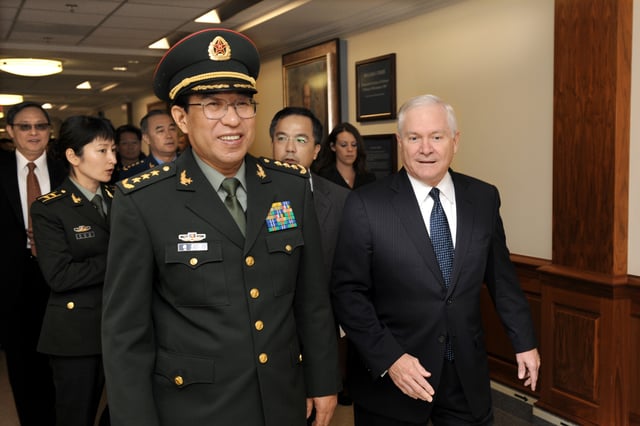
General Xu Caihou of the People's Liberation Army and U.S. Defense Secretary Robert Gates at the Pentagon

Territorial claims in the South China Sea
The PRC's military budget is often mentioned as a threat by many, including the Blue Team. The PRC's investment in its military is growing rapidly. The United States, along with independent analysts, remains convinced that the PRC conceals the real extent of its military spending.[198][199] According to the PRC government, China spent $45 billion on defense in 2007.[200] In contrast, the United States had a $623-billion budget for the military in 2008, $123 billion more than the combined military budgets of all other countries in the world.[201] Some very broad US estimates maintain that the PRC military spends between $85 billion and $125 billion. According to official figures, the PRC spent $123 million on defense per day in 2007. In comparison, the US spent $1.7 billion ($1,660 million) per day that year.[202]
The concerns over the Chinese military budget may come from US worries that the PRC is attempting to threaten its neighbors or challenge the United States. Concerns have been raised that China is developing a large naval base near the South China Sea and has diverted resources from the People's Liberation Army Ground Force to the People's Liberation Army Navy and to air force and missile development.[203][200][204]
Andrew Scobell wrote that under President Hu, objective civilian control and oversight of the PLA appears to be weakly applied.[205]
On October 27, 2009, American Defense Secretary Robert Gates praised the steps China has taken to increase transparency of defense spending.[206] In June 2010, however, he said that the Chinese military was resisting efforts to improve military-to-military relations with the United States.[207] Gates has also said that the United States will "assert freedom of navigation" in response to Chinese complaints about United States Navy deployments in international waters near China.[208] Admiral Michael Mullen has said that the United States seeks closer military ties to China, but will continue to operate in the western Pacific.[209]
A recent report stated that five of six US Air Force bases in the area are potentially vulnerable to Chinese missiles and called for increased defenses.[210]
Meanwhile, the Bulletin of the Atomic Scientists wrote in a 2010 report that the Chinese continue to invest in modernization of their nuclear forces because they perceive that their deterrent force is vulnerable to American capabilities and that further improvement in American missile defenses will drive further Chinese spending in this area.[211]
Chinese defense minister Liang Guanglie has said that China is 20 years behind the United States in military technology.[212]
The International Institute for Strategic Studies in a 2011 report argued that if spending trends continue China will achieve military equality with the United States in 15–20 years.[213]
China and the United States have been described as engaging in a race of military technology. Expansion and development of new weapons by China has been seen as so threatening as to cause planning for withdrawal of US forces from close proximity to China, dispersal of US bases in the region, and development of various new weapon systems. China is also developing capacity for attacking satellites and for cyberwarfare.[214]
In 2012, it was reported that the United States would invite a team of senior Chinese logisticians to discuss the possibility of a first-ever logistics cooperation agreement between the two countries.[215]
Professor James R. Holmes, Chinese specialist at the U.S. Naval War College, has said that China's investments towards a potential future conflict are closer to those of the United States than may first appear, because the Chinese understate their spending, the internal price structures of the two countries are different, and the Chinese only need to concentrate on projecting military force a short distance from their own shores. The balance may shift to the advantage of the Chinese very quickly if they continue double digit yearly growth while the Americans and their allies cut back.[216]
In line with power transition theory, the idea that "wars tend to break out...when the upward trajectory of a rising power comes close to intersecting the downward trajectory of a declining power," some have argued that conflict between China, an emerging power, and the United States, the reigning superpower, is all but inevitable.[217] Amitai Etzioni has argued a "drift toward war" could be avoided by each country accommodating various concerns of the other, combined with collaboration on shared interests such as combating climate change, nuclear non-proliferation, curbing jihadism, and countering open-sea piracy.[218]
Human rights
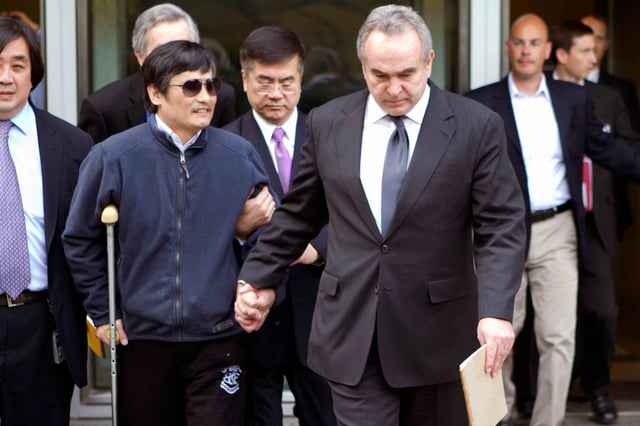
Civil rights activist Chen Guangcheng (left) with former United States ambassador to China Gary Locke (center) and former Assistant Secretary of State for East Asian and Pacific Affairs Kurt M. Campbell (right) at the U.S. Embassy in Beijing on 1 May 2012

China Daily published a cartoon of a shadowed Statue of Liberty holding a tape recorder and microphone instead of a tablet and torch
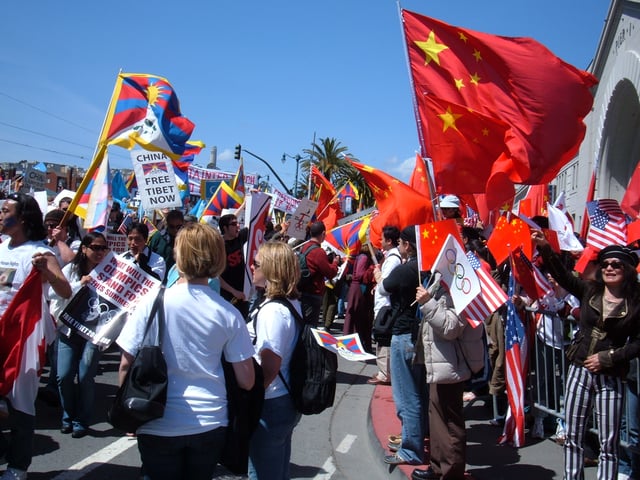
Pro-Tibetan protesters come into contact with pro-Chinese protesters in San Francisco
In 2003, the United States declared that despite some positive momentum that year and greater signs that the People's Republic of China was willing to engage with the US and others on human rights, there was still serious backsliding. China has acknowledged in principle the importance of protection of human rights and has claimed to have taken steps to bring its own human rights practices into conformity with international norms. Among these steps are the signing of the International Covenant on Economic, Social and Cultural Rights in October 1997, ratified in March 2001, and signing of the International Covenant on Civil and Political Rights in October 1998, which has not yet been ratified. In 2002, China released a significant number of political and religious prisoners and agreed to interact with United Nations experts on torture, arbitrary detention, and religion. However, international human rights groups assert that there has been virtually no movement on these promises, with more people being arrested for similar offences since. Such groups maintain that China still has a long way to go in instituting the kind of fundamental systemic change that will protect the rights and liberties of all its citizens in mainland China. The US State Department publishes an annual report on human rights around the world, which includes an evaluation of China's human rights record.[219][220]
In a decision that was criticized by human rights groups, the State Department did not list China as one of the world's worst human rights violators in its 2007 report of human rights practices in countries and regions outside the United States.[221] However, the then-assistant secretary of the State Department's Bureau of Democracy, Human Rights, and Labor Jonathan D. Farrar stated that China's overall human rights record in 2007 remained poor.[221]
On February 27, 2014[227] the United States released its China report on human rights practices for 2013 which, according to its executive summary, described the PRC as an authoritarian state and a place in which repression and coercion were routine.[228] On February 28, 2014, China published a report on human rights in the United States citing surveillance on its own citizens, mistreatment of inmates, gun violence, and homelessness despite having a vibrant economy as important issues.[227]
US criticism of China on human rights, especially on the issue of the Xinjiang re-education camps, significantly expanded at the end of 2018 and during 2019.[229] In March 2019, Secretary of State Mike Pompeo indirectly compared China to the Nazi Germany by saying that roundup of Muslim minorities to movements into camps not seen “since the 1930s.”[230][231] In May 2019, the United States government accused China of putting Uyghurs in "concentration camps".[232] The US government is also considering sanctioning Chinese officials involved in the camps including Chen Quanguo, the Communist Party Secretary of Xinjiang and a member of the 19th Politburo of the Communist Party of China, although a Chinese Politburo member has never been sanctioned by the US government before.[233][234] In July 2019, Vice President Mike Pence accused China of persecuting Christians, Muslims and Buddhists.[235]
Influence in Asia
China's economic rise has led to some geo-political friction between the US and China in the East Asian region.[236] For example, in response to China's response to the Bombardment of Yeonpyeong by North Korea, "Washington is moving to redefine its relationship with South Korea and Japan, potentially creating an anti-China bloc in Northeast Asia that officials say they don't want but may need."[237] For its part, the Chinese government fears a US Encirclement Conspiracy.[238]
China and the US have recently led competing efforts to gain influence in Asian trade and development. In 2015, China led the creation of the Asian Infrastructure Investment Bank, with the goal of financing projects which would spur the development of the lower-tier Asian economies, thus facilitating improved economic ties across the region. It has been suggested that the United States considered the AIIB to be a challenge to the US-backed Asian Development Bank and the World Bank, and sees the Chinese effort as an attempt to set the global economic agenda on terms formulated by the government in Beijing.[239] The Obama administration led an effort to enact the Trans-Pacific Partnership Agreement, a multilateral trade pact between a number of Pacific Rim countries, which excluded China. According to the US Trade Representative, the agreement was designed to “promote economic growth; support the creation and retention of jobs; enhance innovation, productivity and competitiveness; raise living standards; reduce poverty in the signatories' countries; and promote transparency, good governance, and enhanced labor and environmental protections."[240] The deal was placed on hold after the US withdrew from the agreement on 23 January 2017.[241] These efforts are among the attempts by both the US and China to increase their influence over the Asia-Pacific by strengthening their economic ties within the region.
According to an article published on Jura Gentium, Journal of Philosophy of International Law and Global Politics, there is a "new Sphere of Influence 2"[242] shaped mainly by China and the US. Even on social media, if the Western, Japanese and South Korean events and daily life are linked through Facebook, Chinese and American habits and customs are disconnected lacking in social media sharing. This strategy to avoid American influences through social networks is preserved by the Chinese government.
In response to increased American drone strikes against militants on Pakistan's border areas during the Obama administration, the PRC has offered additional fighter jets to Pakistan.[243]
Countries in Southeast Asia have responded to Chinese claims for sea areas by seeking closer relations with the United States.[244] American Defense Secretary Leon Panetta has said that in spite of budget pressures, the United States will expand its influence in the region, in order to counter China's military buildup.[245]
On 7 June 2013, Denny Roy, a senior fellow at the East–West Center in Honolulu, argued in The Diplomat that the United States and China must stop striving for trust and instead emphasize verification.[246] "The argument that trust leads to peace is built on the premise that the suspicions between China and the U.S. are unfounded and would evaporate with more and deeper dialogue. Unfortunately, however, at least some of these suspicions are all too warranted."[246] Whether international law should govern regional affairs in Asia; whether China should be allowed to make expansive sovereignty claims; and what the future strategic roles of South Korea and Japan should be, are issues that, according to Roy, are irreconcilable between China and the U.S.[246] Strategic trust, therefore, is not attainable. "The two countries should strive to manage their inevitable bilateral strategic tensions by reaching agreements where both see a benefit and where compliance is measurable. . . for these inherent rivals and potential adversaries, the emphasis belongs on 'verify,' not 'trust.'"[246]
In the context of US-China relations, a potential application of MAR would be the U.S. pledging not to move its forces into North Korea in the event of a regime collapse, which could be followed by a commitment from China not to move its troops to the DMZ in such an event.
Cyberwarfare and election meddling
The U.S. Department of Justice investigation into the fund-raising activities had uncovered evidence that Chinese agents sought to direct contributions from foreign sources to the Democratic National Committee (DNC) before the 1996 presidential campaign. The Chinese embassy in Washington, D.C. was used for coordinating contributions to the DNC.[247][248]
In 2014, Chinese hackers hacked the computer system of the Office of Personnel Management,[249] resulting in the theft of approximately 22 million personnel records handled by the office.[250] Former FBI Director James Comey stated: "It is a very big deal from a national security perspective and from a counterintelligence perspective. It’s a treasure trove of information about everybody who has worked for, tried to work for, or works for the United States government."[250]
In October 2018, the Senate Homeland Security and Governmental Affairs Committee held a hearing on the threat to the U.S. posed by China. Before the hearing, Bloomberg released an article saying that China is embedding technology in microchips sent to America that collect data on American consumers. However, both FBI Director Christopher Wray and Homeland Security Secretary Kirstjen Nielsen declined to confirm that. Nielsen said that China has become a major threat to the U.S. Nielsen also confirmed, in an answer to a question from a senator, that China is trying to influence U.S. elections.[251]
See also
- General
Air route authority between the United States and China
Chimerica
China containment policy
China Lobby
Chinese Americans
Chinese Century
Chinese espionage in the United States
China-United States trade war
Group of Two
Quadrilateral Security Dialogue
Strategic Economic Dialogue
Taiwan–United States relations
U.S.–China Strategic and Economic Dialogue
- History
East Asia–United States relations
1996 United States campaign finance controversy
Chinatowns in the United States
Cox Report
Hainan Island incident
Hu Na incident
Nixon in China
Permanent normal trade relations
Ping-pong diplomacy
Red Chinese Battle Plan
United States-China Economic and Security Review Commission
U.S. immigration policy toward the People's Republic of China





